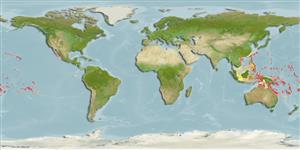>
Blenniiformes (Blennies) >
Blenniidae (Combtooth blennies) > Salariinae
Etymology: Cirripectes: Latin, cirrus = curl fringe + Greek, pektos, -e, -on = made of several parts solidly united (Ref. 45335).
More on author: Valenciennes.
Environment: milieu / climate zone / depth range / distribution range
Sinh thái học
Biển Cùng sống ở rạn san hô; Mức độ sâu 0 - 31 m (Ref. 529), usually 1 - 5 m (Ref. 58302). Tropical; 28°N - 28°S
Pacific Ocean: Palau to Johnston Islands, Marquesas and Pitcairn Islands, north to the Bonin Islands, south to Rapa; throughout Micronesia.
Length at first maturity / Bộ gần gũi / Khối lượng (Trọng lượng) / Age
Maturity: Lm ?, range 6 - ? cm
Max length : 8.9 cm SL con đực/không giới tính; (Ref. 529)
Các tia vây lưng cứng (tổng cộng) : 11 - 13; Các vây lưng mềm (tổng cộng) : 13 - 15; Tia cứng vây hậu môn: 2; Tia mềm vây hậu môn: 14 - 16; Động vật có xương sống: 29 - 31. Dorsal fin XII, 14, membrane attached to caudal fin, with deep notch above last spine, first spine slightly higher than second; anal fin II, 15; pectoral rays 15; pelvic fin I, 4; caudal fin procurrent rays 10-14. Vertebrae 10 + 20. LL, without scales but with scalelike flaps; LL tubes 1-11, canal ends below 7th dorsal ray and caudal-fin base. Lower lip smooth mesially, plicate laterally. Upper lip crenulae 37-51. Gill rakers 23-29. Cephalic pore system complex; midsnout pores present. Cirri, supraorbital 4-14, nasal 4-19; nuchal 27-38, in 4 groups, bases of ventralmost groups slightly expanded. Adults with brown body; red spots or narrow lines on snout and around the eye; iris silvery (Ref. 529). Anterior nare is tubular and provided with an apical lid that prevents the penetration of sand particles (Ref. 94108).
Facultative air-breathing in the genus (Ref. 126274); Adults inhabit exposed seaward reefs where it usually shelters at bases or among the branches of Pocilloporid corals (Ref. 1602). Feeds on benhic algae (Ref. 89972). Benthic (Ref. 58302). Oviparous. Eggs are demersal and adhesive (Ref. 205), and are attached to the substrate via a filamentous, adhesive pad or pedestal (Ref. 94114). Larvae are planktonic, often found in shallow, coastal waters (Ref. 94114).
Oviparous, distinct pairing (Ref. 205). Urogenital orifice of male genital papilla located basally between 2 widely separated slender filaments on a fleshy swelling behind anus; testes bulbous with length equal its width (Ref. 529).
Williams, J.T., 1988. Revision and phylogenetic relationships of the blenniid fish genus Cirripectes. Indo-Pac. Fish. (17):78 p. (Ref. 529)
IUCN Red List Status (Ref. 130435: Version 2024-2)
Threat to humans
Harmless
Human uses
Các nghề cá: không ích lợi (thú vị); Bể nuôi cá: Tính thương mại
Các công cụ
Special reports
Download XML
Các nguồn internet
Estimates based on models
Preferred temperature (Ref.
123201): 24.9 - 29.3, mean 28.2 °C (based on 1525 cells).
Phylogenetic diversity index (Ref.
82804): PD
50 = 0.5000 [Uniqueness, from 0.5 = low to 2.0 = high].
Bayesian length-weight: a=0.01047 (0.00461 - 0.02381), b=2.98 (2.79 - 3.17), in cm total length, based on LWR estimates for this (Sub)family-body shape (Ref.
93245).
Mức dinh dưỡng (Ref.
69278): 2.0 ±0.00 se; based on food items.
Thích nghi nhanh (Ref.
120179): Chiêù cao, thời gian nhân đôi của chủng quần tối thiểu là dưới 15 tháng (Preliminary K or Fecundity.).
Fishing Vulnerability (Ref.
59153): Low vulnerability (10 of 100).
Nutrients (Ref.
124155): Calcium = 138 [72, 238] mg/100g; Iron = 0.908 [0.544, 1.483] mg/100g; Protein = 18.3 [17.1, 19.3] %; Omega3 = 0.142 [0.085, 0.234] g/100g; Selenium = 23.5 [12.9, 45.9] μg/100g; VitaminA = 127 [36, 437] μg/100g; Zinc = 2.58 [1.75, 3.68] mg/100g (wet weight);
